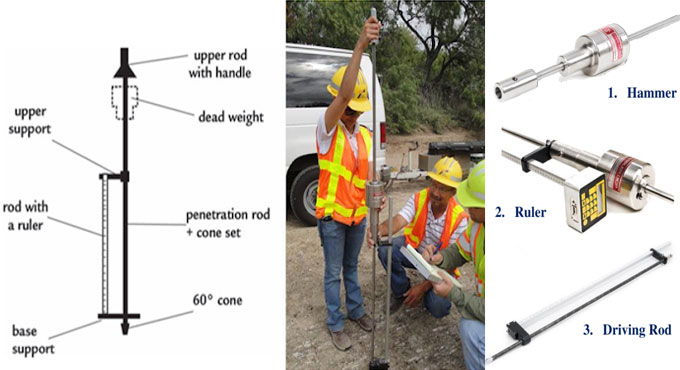
Dynamic Cone Penetrometer: what and how
Dynamic Cone Penetrometer, or DCP, is an instrument utilized for assessing the quality of soils nearby. It likewise assists with observing the state of granular layers and subgrade soils in asphalt segments after some time. It tends to be utilized to decide the correct answers for the destinations, particularly when delicate soils are included.
It is additionally applied when the CBR estimation of compacted soil sub-level underneath the current street asphalt is to be resolved. Ceaseless readings can be brought down to a profundity of 800 mm or, when an expansion rod is fitted, to a profundity of up to 1200 mm.
The DCP is a basic and compact instrument. It comprises a solidified cone shaped tip, standard measurement steel rod, and a standard weight hammer(8kg), which is dropped from the highest point of the rod against an anvil to propel the tip into the ground.
Parts in a DCP
The device of the instrument includes the accompanying parts:
1. Handle
2. Top Rod
3. Hammer (8kg)
4. Anvil
5. Handguard Cursor
6. Base Rod
7. 1m rule
8. 60 degree Cone
9. Tommy bars and spanners (these guarantee that the screwed joints are kept tight consistently)
The accompanying joints ought to be made sure about with a solid glue or comparative non-solidifying string locking compound before use:
(i) Handle/top rod
(ii) Anvil/base rod
(iii) Bottom rod/cone
The hammer is lifted to the highest point of the rod and discharged so as to drive the rod into the ground. With the assistance of the inserted vertical scale, the penetration(in inches or millimeters) is recorded after the blows of the hammer.
Connections have been set up between estimations with California Bearing Ratio (CBR) and DCP so the result can be deciphered and contrasted and CBR details for asphalt structure.
Method
After the instrument is set up, the zero reading of the mechanical assembly is recorded. This is finished by setting the DCP on a hard surface, guaranteeing its verticality, and afterward noticing down the zero reading in the fitting spot on the proforma.
The instrument is held vertical, and the weight is painstakingly raised to the handle. The weight ought not contact the handle before it is permitted to drop, and that the administrator should let it fall uninhibitedly and don't bring it down with his hands.
It is exhorted that a reading ought to be taken at additions of infiltration of about 10mm. Be that as it may, it is normally simpler to take a scale reading after a set number of blows. It is, hence, important to change the quantity of blows between readings as per the quality of the layer being infiltrated.
For good quality granular bases, readings after each 5 or 10 blows are ordinarily palatable, however for more vulnerable sub-base layers and sub-grades, readings after each 1 or 2 blows might be proper.
After the culmination of the test, DCP is evacuated by delicately tapping the weight upwards against the handle. It ought to be finished with alert as though done energetically, the life of the instrument will be diminished.
Advantages of using a DCP
Soil data is regularly constrained, and is frequently gathered from inside the degrees of the establishment zone, yet one may likewise need to survey the soils elsewhere on the site. Data in regards to the variety of soil quality with profundity can be acquired, which can be basic for building up the best answer for unsatisfactory subgrade soils.
One can gather data from a great deal of focuses moderately rapidly, so you can perceive how soil conditions change over the site and react in like manner. One gets exact and exact data on the soil conditions in the field and at development time.


